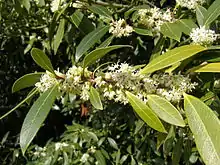Osmanthus
Osmanthus /ɒzˈmænθəs/[3] is a genus of about 30 species of flowering plants in the family Oleaceae. Most of the species are native to eastern Asia (China, Japan, Korea, Indochina, the Himalayas, etc.) with a few species from the Caucasus, New Caledonia and Sumatra.[1][4]
| Osmanthus | |
|---|---|
 | |
| Osmanthus heterophyllus in flower | |
| Scientific classification | |
| Kingdom: | Plantae |
| Clade: | Tracheophytes |
| Clade: | Angiosperms |
| Clade: | Eudicots |
| Clade: | Asterids |
| Order: | Lamiales |
| Family: | Oleaceae |
| Tribe: | Oleeae |
| Subtribe: | Oleinae |
| Genus: | Osmanthus Lour. |
| Synonyms[1][2] | |
| |
Osmanthus range in size from shrubs to small trees, 2–12 m (7–39 ft) tall. The leaves are opposite, evergreen, and simple, with an entire, serrated or coarsely toothed margin. The flowers are produced in spring, summer or autumn, each flower being about 1 cm long, white, with a four-lobed tubular-based corolla ('petals'). The flowers grow in small panicles, and in several species have a strong fragrance. The fruit is a small (10–15 mm), hard-skinned dark blue to purple drupe containing a single seed.[4]
Species
- Osmanthus armatus Diels – Shaanxi, Sichuan, Hubei, Hunan
- Osmanthus attenuatus P.S.Green – Guangxi, Guizhou, Yunnan
- Osmanthus austrocaledonicus (Vieill.) Knobl. – New Caledonia
- Osmanthus cooperi Hemsl. – Anhui, Fujian, Jiangsu, Jiangxi, Zhejiang
- Osmanthus cymosus (Guillaumin) P.S.Green – New Caledonia
- Osmanthus decorus (Boiss. & Balansa) Kasapligil – Caucasian osmanthus – Turkey, Caucasus
- Osmanthus delavayi Franch. – Guizhou, Sichuan, Yunnan
- Osmanthus didymopetalus P.S.Green – Guangdong, Hainan
- Osmanthus enervius Masam. & T.Mori – Taiwan, Nansei-shoto
- Osmanthus fordii Hemsl. – Guangdong, Guangxi
- Osmanthus fragrans Lour. – Sweet osmanthus, sweet olive, fragrant tea olive – Himalayas (northern and eastern India, Nepal, Bhutan, Assam), Indochina (Myanmar, Thailand, Cambodia, Vietnam), Japan, China (Guizhou, Sichuan, Yunnan, Sichuan), Taiwan
- Osmanthus gracilinervis L.C.Chia ex R.L.Lu – Guangdong, Guangxi, Hunan, Jiangxi, Zhejiang
- Osmanthus hainanensis P.S.Green – Hainan
- Osmanthus henryi P.S.Green – Guizhou, Hunan, Yunnan
- Osmanthus heterophyllus (G.Don) P.S.Green – Holly osmanthus, holly olive, false holly, hiiragi – Japan, Taiwan, Nansei-shoto
- Osmanthus insularis Koidz. – Korea, Japan, Nansei-shoto, Ogasawara-shoto,
- Osmanthus iriomotensis T.Yamaz – Nansei-shoto
- Osmanthus kaoi (T.S.Liu & J.C.Liao) S.Y.Lu – Taiwan
- Osmanthus lanceolatus Hayata – Taiwan
- Osmanthus monticola (Schltr.) Knobl. – New Caledonia
- Osmanthus pubipedicellatus L.C.Chia ex H.T.Chang – Guangdong
- Osmanthus reticulatus P.S.Green – Guangdong, Guangxi, Guizhou, Hunan, Sichuan
- Osmanthus rigidus Nakai – Kyushu
- Osmanthus serrulatus Rehder in C.S.Sargent – Sichuan
- Osmanthus suavis King ex C.B.Clarke in J.D.Hooker – Assam, Bhutan, Nepal, Sikkim, Myanmar, Yunnan, Tibet
- Osmanthus urceolatus P.S.Green - Sichuan, Hubei
- Osmanthus venosus Pamp. – Hubei
- Osmanthus yunnanensis (Franch.) P.S.Green – Yunnan, Tibet
Species transferred to Cartrema:[2][5]
- Osmanthus americanus (L.) A.Gray – Devilwood – southeastern US from Texas to Virginia; eastern and southern Mexico
- Osmanthus floridanus Chapman - Florida
- Osmanthus marginatus (Champ. ex Benth.) Hemsl. – Nansei-shoto, Taiwan, Vietnam, Anhui, Fujian, Guangdong, Guangxi, Guizhou, Hainan, Hunan, Jiangxi, Sichuan, Yunnan, Zhejiang
- Osmanthus matsumuranus Hayata – Assam, Thailand, Laos, Cambodia, Vietnam, Anhui, Guangdong, Guangxi, Guizhou, Jiangxi, Taiwan, Yunnan, Zhejiang
- Osmanthus minor P.S.Green – Fujian, Guangdong, Guangxi, Jiangxi, Zhejiang
- Osmanthus scortechinii King & Gamble – Thailand, Sumatra, Pen Malaysia
- Osmanthus sumatranus P.S.Green – Sumatra
- Garden hybrids
- Osmanthus × burkwoodii (Burkwood & Skipwith) P.S.Green (O. delavayi × O. decorus)
- Osmanthus × fortunei Carrière (O. fragrans × O. heterophyllus)
Cultivation

Osmanthus are popular shrubs in parks and gardens throughout the warm temperate zone. Several hybrids and cultivars have been developed. Osmanthus flower on old wood and produce more flowers if unpruned. A pruned shrub often produces few or no flowers for one to five or more years, before the new growth matures sufficiently to start flowering.
In Japan, sweet osmanthus (gin-mokusei) is a favorite garden shrub. Its small white flowers appear in short-stalked clusters in late autumn. It has an intense sweet fragrance. A variant with deep golden flowers (kin-mokusei) is also popular.
Uses
The flowers of O. fragrans are used throughout East Asia for their scent and flavour, which is likened to apricot and peach.
In China, osmanthus tea (桂花茶, guìhuāchá) combines sweet osmanthus flowers with black or green tea leaves. Sweet osmanthus and osmanthus tea are particularly associated with the city of Guilin (桂林, literally "Forest of Sweet Osmanthus").
Osmanthus wine is prepared by infusing whole Osmanthus fragrans flowers in huangjiu or other types of rice wine and is traditionally consumed during the Mid-Autumn Festival.
References
- Kew World Checklist of Selected Plant Families
- Nesom, G.L. 2012. Synopsis of American Cartrema (Oleaceae). Phytoneuron 2012-96: 1–11.
- Sunset Western Garden Book, 1995:606–607
- Flora of China, v 15 p 286, 木犀属 mu xi shu, Osmanthus Loureiro, Fl. Cochinch. 1: 28. 1790.
- José Ignacio De Juana Clavero, Cambios nomenclaturales en la sección Leiolea (Spach) P. S. Green, del género Osmanthus Lour. (Oleaceae), Bouteloua 22: 28-39 (XI-2015)
External links
| Wikimedia Commons has media related to Osmanthus. |
 Data related to Osmanthus at Wikispecies
Data related to Osmanthus at Wikispecies
